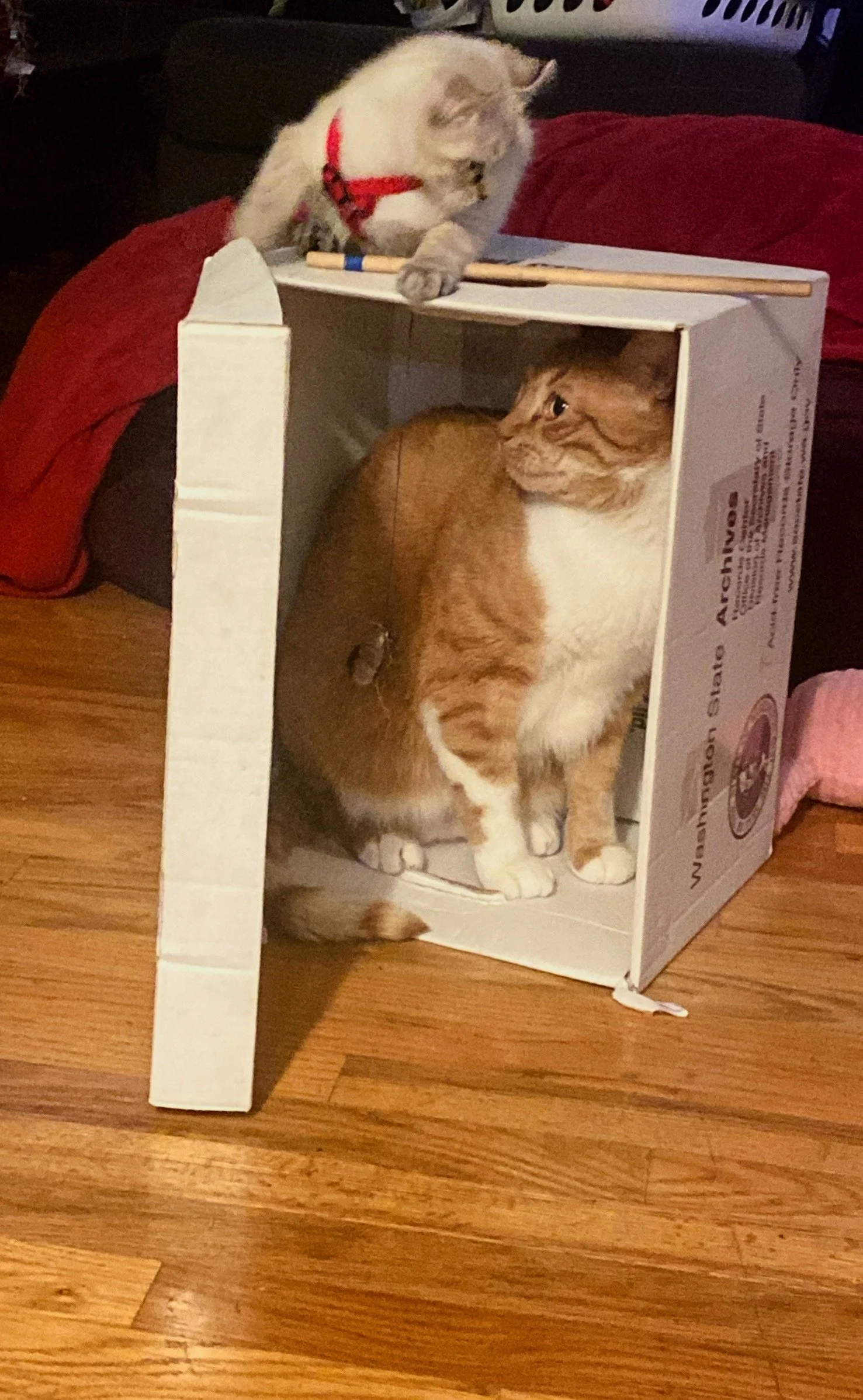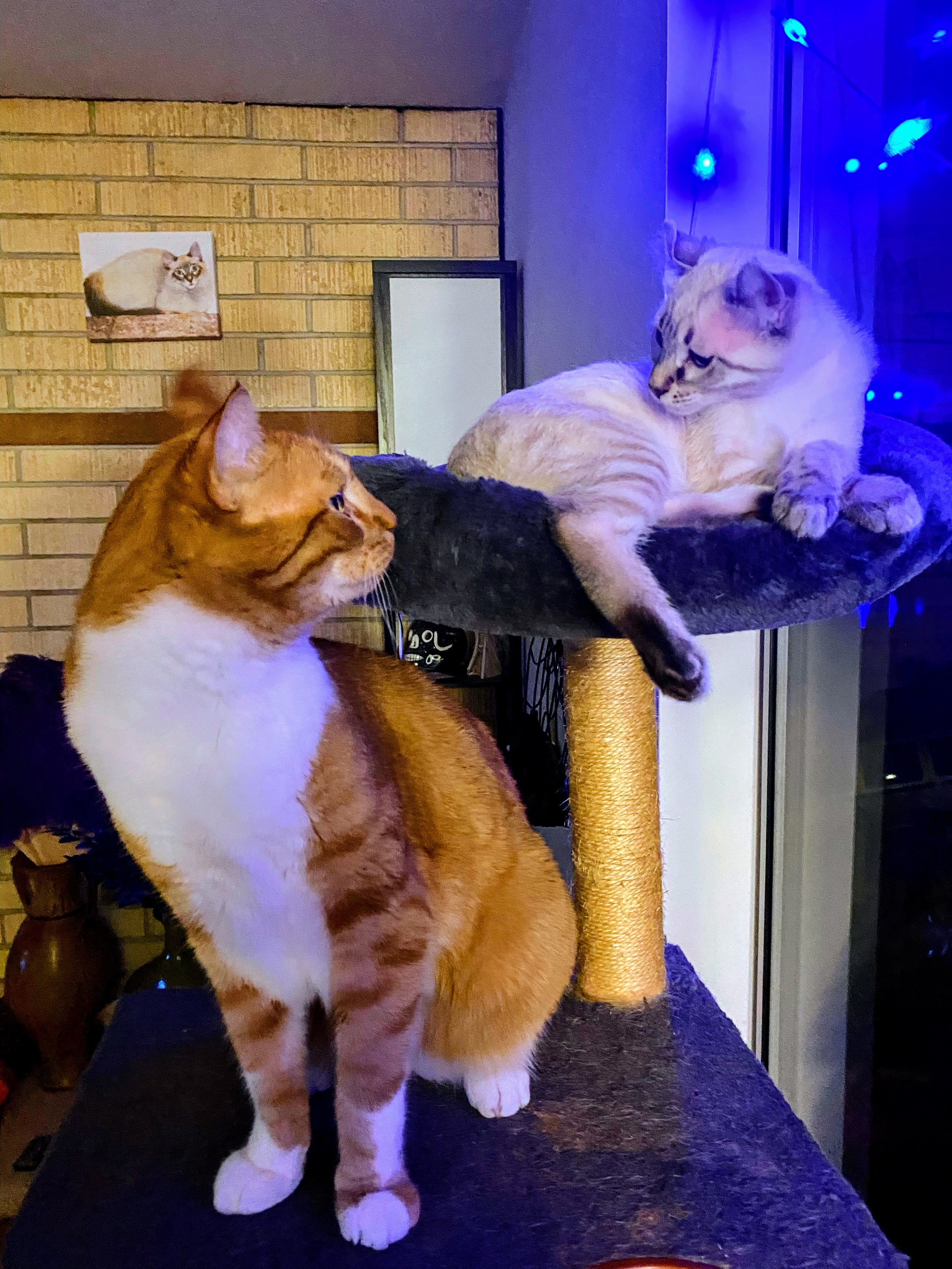
The Art of Introducing Cats: Achieve Harmony in the Home
Introduction: Welcoming a New Whiskered Member – The Art of Smooth Introductions

Bringing a new cat into your home is not just an addition to your family; it's the beginning of a new chapter of companionship and joy. However, this transition, filled with curiosity and cautious sniffs, is a delicate dance for both the newcomer and the household. The importance of a smooth introduction process cannot be overstated. It lays the foundation for a harmonious coexistence, whether you're a first-time cat owner or a seasoned pet lover expanding your furry family.
In this guide, we'll explore the nuances of introducing a new cat into your home – tailoring our advice to cater to both scenarios: households welcoming their first cat and homes that already resonate with the purrs and paws of other animals. Each situation presents its unique challenges and moments of delight. From setting up a safe space to gradual introductions, we'll cover the essential steps to ensure a peaceful and happy integration. So, let's embark on this exciting journey together, providing the newest addition to your family feels accepted and truly at home.
Section 1: Introducing a New Cat into a Cat-Only Household
Introducing a new cat into a household where feline personalities already reign requires a blend of patience, understanding, and strategy. The goal is to create a welcoming environment for the new arrival while respecting the established territories and routines of your existing cat(s). Let's explore the steps to ensure a smooth integration.
Preparation Before the New Cat Arrives
1. Create a Separate Space:
You can set up a comfortable, private area for your new cat. This space should include all the essentials – a litter box, food and water dishes, a cozy bed, and some toys. This space must be separate from your resident cat's area to prevent initial territorial disputes.
2. Update Vet Visits:
Please ensure that both the new and existing cats are up-to-date with vaccinations and have a clean bill of health. This step is crucial to prevent the spread of any potential illnesses.
3. Gather Scent Items:
Collect blankets or toys with the scent of your resident cat to place in the new cat’s space and vice versa. This scent swapping is a subtle way to introduce them to each other's presence.
The Gradual Introduction Process
1. Initial Separation:
Please keep the new cat in its separate space first. This allows both cats to get used to each other's scent without direct contact, reducing stress and aggression.
2. Controlled Visual Contact:
Once comfortable with the scent, you can introduce visual contact through a gate or a slightly opened door. This should be done for short periods under supervision.
3. Supervised Meetings:
Gradually allow face-to-face interactions under close supervision. These meetings should be brief at first, gradually increasing in duration.
Recognizing Behaviors
1. Positive Signs:
Look for calm body language, curious glances, or playful gestures. A lack of aggression, such as hissing or growling, is also a good sign.
2. Negative Reactions:
Watch for signs of stress or aggression like flattened ears, fur puffing, hissing, or swatting. If these occur, revert to the earlier step of the introduction process.
To remind you, patience is essential. Some cats may coexist peacefully after a few days, while others may take weeks or months. Respect their pace and continue providing love and reassurance to your new and resident cats throughout this process.
Section 2: Introducing a New Cat to a Household with Other Animals
The dynamics can be even more intricate when introducing a new old to other animals, whether dogs, cats, or smaller pets like rabbits or guin cats to house pigs. The key lies in thoughtful preparation, understanding each animal's nature, and careful management of their initial interactions.
Essential Preparations
1. Separate Spaces:
You can set up a private area for your new cat, complete with all their necessities. This should be a calm, secure space where they can retreat and feel safe. Review our article From Bush to Tree: Crafting a Cat Haven for All Climbers
2. Health Check:
Please ensure all pets are healthy and up-to-date with their vaccinations to avoid health risks.
3. Scent Introduction:
Before face-to-face introductions, let your pets get familiar with each other’s scent: exchange bedding or toys between the new cat and the resident animals.
Gradual Introduction Process
1. Cats and Dogs:
Dogs can be overly enthusiastic, which might intimidate your new cat. Keep the dog on a leash and watch their body language closely during initial interactions: reward calm and non-aggressive behaviors from both the dog and the cat.

2. Cats and Other Cats:
Follow the similar gradual process outlined in Section 1. Ensure each cat has their resources (like litter boxes and feeding areas) to minimize competition and stress.
3. Cats and Small Pets:
Small animals can trigger a cat's predatory instincts. Keep them in their enclosures when introducing them to the new cat. Monitor the cat’s behavior closely for signs of excessive focus or aggression.
Managing Initial Interactions
1. Control and Supervision:
Always supervise initial interactions. For dogs, use a leash or a barrier for control. With other cats or small pets, use a gradual introduction with controlled environments.

2. Look for Body Language Cues:
Positive signs include a calm demeanor and curiosity. Signs of stress or aggression, like growling, hissing, or fixating, should be taken seriously. If you notice these behaviors, separate the animals and slow the process.
3. Patience is Vital:
Each animal will adapt quickly. It may take several days to weeks for pets to get comfortable with each other. Please don't rush the process, and make sure each pet is secure and attended to during this transition.
Ensuring Safety
1. Separate When Unsupervised:
Keep the new cat and other pets separated until you're confident about their peaceful coexistence, especially when you're not there to supervise.
2. Consistent Training:
For households with dogs, reinforce basic obedience training to control the dog's behavior around the new cat.

.
3. Escape Routes:
Please ensure your new cat always has access to a safe space or escape route in case they feel threatened.
Remember, every pet has a unique personality, and their response to new family members can vary widely. Your patience, attentiveness, and consistent supervision during this period are crucial to a successful integration.
Section 3:Common Challenges and How to Address Them
Introducing a new cat into your home, whether other pets already occupy it or not, can come with challenges. Recognizing and addressing these early on is crucial for a peaceful coexistence. Let's delve into some common issues and practical strategies to handle them.
1. Aggression
Aggression from the new cat or the resident pets is a common challenge. It can manifest as hissing, growling, swatting, or even biting.
Strategies:
-
Increase Separation Time: If aggression occurs, increase the time the animals spend separated, slowing the introduction process.
-
Positive Reinforcement: Reward calm and non-aggressive behaviors with treats and praise.
-
Professional Help: If the aggression is severe or doesn't improve, consider consulting a veterinarian or an animal behaviorist.
2. Territorial Behavior
Cats are naturally territorial, and a new arrival can disrupt the existing hierarchy in your home.
Strategies:
-
Separate Resources: Ensure each pet has its own food bowls, beds, and litter boxes to reduce competition.
-
Scent Swapping: Continue with scent-swapping strategies to help pets get used to each other.
-
Safe Spaces: Provide plenty of high perches and hiding spots for cats to retreat if they feel overwhelmed.
3. Stress and Anxiety
Change can be stressful for animals, leading to behaviors like hiding, decreased appetite, or litter box issues.
Strategies:
-
Create a routine: Regularly feed, play, and cuddle.
-
Environmental Enrichment: Provide toys, scratching posts, and interactive playtime to keep your pets mentally stimulated and reduce stress.
-
Pheromone Diffusers: Products like Feliway can help calm cats and reduce stress in multi-cat households.
Handling Conflicts
Conflicts may arise as pets establish their new social structure. When conflicts occur:
1. Do Not Punish:
Avoid punishing the pets, as this can increase stress and aggression.
2. Calm Intervention:
If a fight occurs, separate the pets calmly and quietly. Use a blanket or a large piece of cardboard to block their vision of each other.
3. Reassess the Situation:
Could you step back in the introduction process if conflicts continue? This may involve keeping the pets separated for a more extended period and reintroducing them more slowly.
Maintaining a Peaceful Coexistence
Monitor Interactions:
-
Keep an eye on how your pets interact and continue supervising their meetings until you are sure they are comfortable with each other.
-
Veterinary Advice: If problems persist, seek advice from a vet. They can rule out any health issues contributing to the behavior and provide additional strategies.
4. Litter Box Problems
New or existing cats may experience changes in litter box habits due to stress or territorial issues.
Strategies:
-
Multiple Litter Boxes: Have one more litter box than the number of cats in your home, placed in different, quiet locations. It is essential to keep it clean, or they may start having accidents in the house. Review our blog Finding the Perfect Litter Box: Is Electric Worth the Price?’
-
Litter Preferences: Some cats prefer certain types of litter. Observe if the new cat has a different preference, and let me know if it works.
5. Lack of Interest in Eating or Playing
Stress can lead to losing appetite or disinterest in play, particularly in the new cat.
Strategies:
-
Quiet Feeding Area: Provide a calm, separate space for the new cat to eat without feeling threatened.
-
Encourage Play: Engage the new cat in play using toys that stimulate their hunting instincts. This can also encourage interaction between pets.
6. Over-Grooming or Self-Isolation
Cats under stress may over-groom themselves or hide more than usual.
Strategies:
-
Create Safe Havens: Ensure your new cat has places to hide where they feel secure. Review our article on Title: Creating the Perfect Haven for Tree and Bush Dweller Cats
-
Reduce Stress: Use pheromone diffusers or soft music to create a calming environment.
-
Health Check: If over-grooming is severe, consult a vet to rule out medical issues.
Handling Long-Term Adjustments
Even after the initial introduction period, monitoring the dynamics in your multi-pet household remains essential.
1. Consistent Routines:
I'd like for you to maintain consistent feeding, play, and attention routines for all pets.
2. Ongoing Supervision:
Continue supervising interactions, especially in situations that previously led to conflict.
3. Continued Socialization:
Regular, controlled socialization opportunities help maintain a peaceful environment.
Remember the Individual Needs of Each Pet
-
Each cat has its personality and needs. Pay attention to these individual preferences and adjust your approach accordingly.
-
Reinforce positive behavior with treats and affection to build a bond between the new cat and the resident pets.
Patience and persistence are essential in navigating these challenges. It's important to remember that while some cats adjust quickly, others may take several weeks or even months. Understanding and addressing these common issues with care and attention can help foster a harmonious and happy home for all your pets.
Conclusion: Patience Paves the Path to Harmony
As we reach the end of our guide on introducing a new cat to your household, whether it's a first-time addition, a feline expansion, or a mix of different pets, let's recap the key points to ensure a smooth transition:
1. Preparation is Crucial:
Setting up separate spaces and using scent swapping are essential first steps.
2. Gradual Introduction:
Slow, supervised introductions help prevent aggression and stress.
3. Recognizing and Addressing Challenges:
Be vigilant about territorial behavior, aggression, and stress. Employ strategies such as providing separate resources, maintaining routines, and seeking professional advice.
4. Ongoing Adjustment:
Continuous monitoring and adapting to each pet's needs are vital for long-term harmony.
I want you to know that embarking on this journey requires patience, understanding, and persistence. Remember, the pace of progress will vary from one pet to another. Some may adapt swiftly, while others take longer to accept their new furry companions. Respecting these individual timelines and providing constant support and reassurance to all your pets throughout this process is essential.
The effort and time invested in this introduction phase come with rewarding dividends. A peaceful multi-pet household offers your pets companionship among themselves and enriches your life with their harmonious coexistence. The joy of watching your pets live together in comfort and peace is a heartwarming experience that makes all the patience and hard work worthwhile.
So, please take a deep breath, arm yourself with these strategies, and walk forward. You are creating a loving and inclusive home – a sanctuary where every purr, wag, or squeak contributes to the symphony of your happy, multi-pet family.
Join the Conversation and Stay Connected
Share Your Experiences & Join Our Community
Have you tried harness training with your cat? We'd love to hear about your journey! Whether it's a story of success, a funny moment, or even the challenges you faced, your experiences are valuable to our community. Please share your stories in the comments below, and let's learn from each other.
Stay Updated with Our Newsletter
Take advantage of more insightful guides and cat care tips. Join our newsletter for the latest updates, stories, and advice tailored for cat lovers like you. It's your go-to source for everything feline, from health and nutrition to behavior and play. Sign up now to stay in the loop and join our growing cat-loving community.




